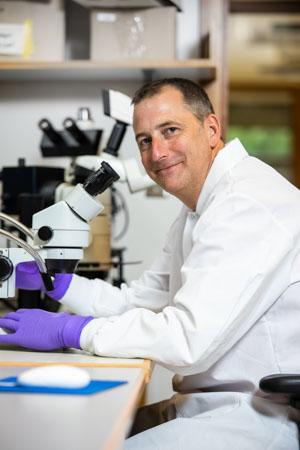Vision changes are an inevitable part of aging, but why are some people more susceptible to age-related eye diseases and why do some individuals experience more severe decline than others? New research from The Jackson Laboratory (JAX) reveals that genetics play a key role in how the eye ages, with different genetic backgrounds influencing retinal aging in distinct ways.

Gareth Howell, professor and Diana Davis Spencer Foundation Chair for Glaucoma Research. Photo credit The Jackson Laboratory.
The study, published in Molecular Neurodegeneration, examined age-related changes in genes and proteins of the retinas of nine strains of mice, mimicking the genetic variability found in humans. While all mice exhibited expected signs of aging, the severity and nature of these changes varied significantly between the nine strains.
Traditionally, studies of retinal aging and disease have relied on a single strain of genetically identical mice, limiting researchers’ ability to understand the role of genetic variation. “Observing how aging occurs in one strain of mice might not be relevant to all mice – or humans," said Gareth Howell, professor and Diana Davis Spencer Foundation Chair for Glaucoma Research at JAX, who led the research. "To overcome the limitations of previous studies, we wanted to know how genetic context drives aging of the retina.”
Howell and his team leveraged nine strains of mice with different genetic backgrounds designed to better reflect human variability, generating data on age-related genetic and molecular changes in young and old mice. With their dataset now publicly available, Howell and his team hope their findings will help other scientists studying aging and vision loss – work that may also improve the utility of the eye as a window to the brain to predict neurological decline.
JAX news story